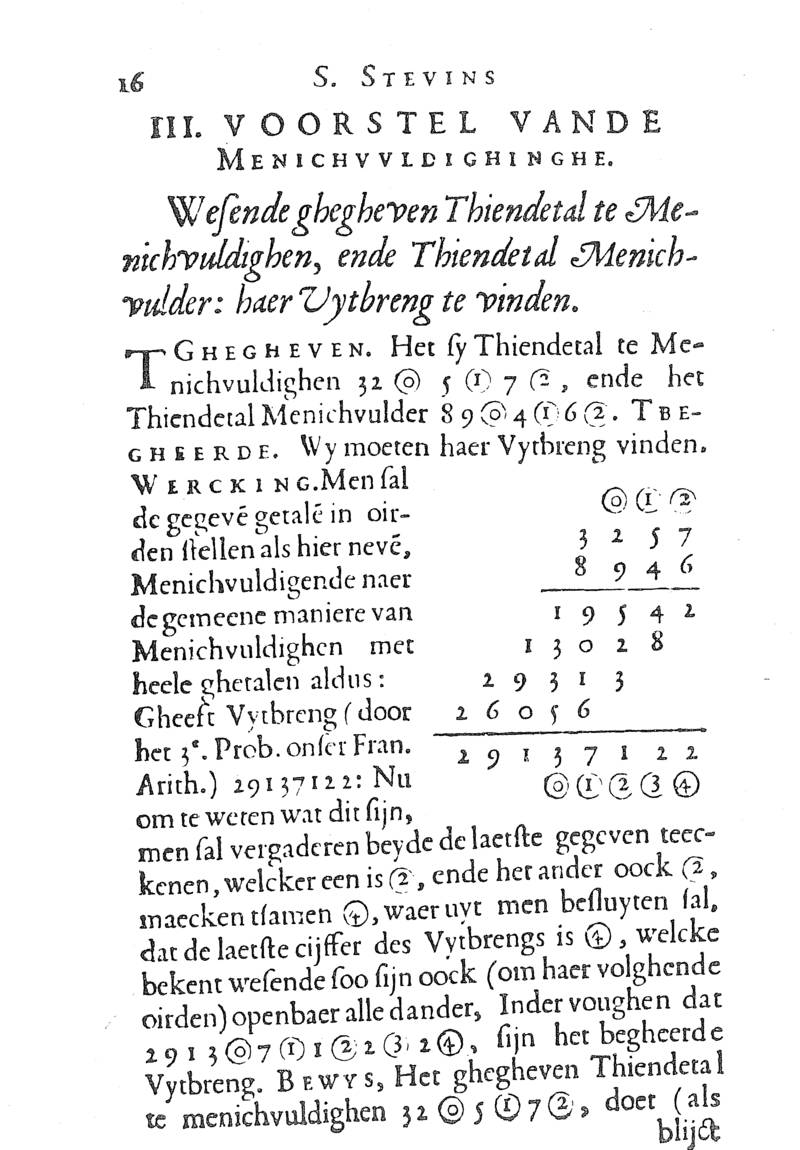- About MAA
- Membership
- MAA Publications
- Periodicals
- Blogs
- MAA Book Series
- MAA Press (an imprint of the AMS)
- MAA Notes
- MAA Reviews
- Mathematical Communication
- Information for Libraries
- Author Resources
- Advertise with MAA
- Meetings
- Competitions
- Programs
- Communities
- MAA Sections
- SIGMAA
- MAA Connect
- Students
- MAA Awards
- Awards Booklets
- Writing Awards
- Teaching Awards
- Service Awards
- Research Awards
- Lecture Awards
- Putnam Competition Individual and Team Winners
- D. E. Shaw Group AMC 8 Awards & Certificates
- Maryam Mirzakhani AMC 10 A Awards & Certificates
- Two Sigma AMC 10 B Awards & Certificates
- Jane Street AMC 12 A Awards & Certificates
- Akamai AMC 12 B Awards & Certificates
- High School Teachers
- News
You are here
'In these numbers we use no fractions': A Classroom Module on Stevin's Decimal Fractions - Element III. Concentrating on the Mathematics, or Clarifying Conceptions of Decimal Fractions
Lastly, I wanted the PSMTs to read, interpret, and use the notions about decimal fractions (and their notation!) introduced by Stevin. The prospective teachers used the translation provided by Phill Schultz to respond to the following questions. (I use here, as many others have before, parentheses around the “Commencements”, “Primes”, “Seconds”, and so forth – as opposed to the circles used by Stevin.)
- Using “The third proposition: of Multiplication”, explain Stevin’s explication and demonstration of multiplying 32(0) 5(1) 7(2) and 89(0) 4(1) 6(2).
-
At the end of the demonstration, Stevin writes (modern English provided):
It is then the true product which we were to demonstrate. But to show why (2) multiplied by (2) gives the product (4) which is the sum of their numbers, also why (4) by (5) produces (9), and why (0) by (3) produces (3) etc. Let us take 2/10 and 3/100 which (by the third Definition of this Disme) are 2(1) 3(2) their product is 6/1000 [corrected from the original] which value by the said third Definition 6(3), multiplying then (1) by (2) the product is (3) namely a sign compounded of the sum of the numbers of the signs given.
Conclusion: A Disme number to multiply, and to be multiplied, being given, we have found the product, as we ought.
With regard to his explication and demonstration, does Stevin’s description work? (You may find it helpful to translate his example in this paragraph.) Is this how you remember the explanation/demonstration of why we add the total number of decimal places for the product? If not, what explanation were you given? Or, if you don’t remember, what explanation/demonstration would you give for how to determine the number of decimal places there are in the product of two decimal numbers? Why?

First page of the section on multiplication of decimal numbers from Simon Stevin's 1585 De Thiende. The language is Flemish (closely related to Dutch).
Quick Reflection III
The use of almost every original source (or a translation) from the history of mathematics will create some amount of discomfort with even the best mathematics students. Often with students preparing to teach mathematics, the discomfort can be a little more severe given the strength of beliefs about how and what to teach. Using the English translation of Stevin’s De Thiende was not as difficult as other such texts that I have used. Even so, upon first glance at the material, Cassy (see her reflection below) exclaimed: “I’m not really feeling good about Stevin!” For her (she was preparing to teach middle grades mathematics), investigating a mathematical topic from such a different perspective was disturbing to say the least. What was most powerful about sharing this activity with students was their overwhelming agreement that a brief treatise from 1585 had re-introduced them to the equivalent – yet often disguised – meaning of:
8.749 = 8 + \(\frac{7}{10}\) + \(\frac{4}{100}\) + \(\frac{9}{1000}\) = \(\frac{8749}{1000}\).
And, if we multiplied this number by 32.57, or
32.57 = 32 + \(\frac{5}{10}\) + \(\frac{7}{100}\) = \(\frac{3257}{100}\),
the resulting product was
\(\frac{8749}{1000}\) x \(\frac{3257}{100}\) = \(\frac{28495493}{100000}\).
Finally, writing as a mixed numeral, we found
\(\frac{28495493}{100000}\) = 284 + \(\frac{95493}{100000}\) = 284.95493.
Indeed, why the number of decimal places in this particular product was in fact five was a revelation for the majority of the PSMTs – years after learning multiplication of decimals themselves.
(Note: The example above was discussed in class as a result of reading the PSMTs’ reflections on the task. Although the value 32.57 is found in Stevin’s Proposition 3, this example is not found in his text.)
Kathleen M. Clark (The Florida State University), "'In these numbers we use no fractions': A Classroom Module on Stevin's Decimal Fractions - Element III. Concentrating on the Mathematics, or Clarifying Conceptions of Decimal Fractions," Convergence (January 2011), DOI:10.4169/loci003333




